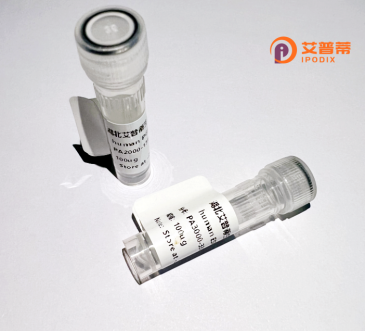
| 纯度 | >90%SDS-PAGE. |
| 种属 | Human |
| 靶点 | UNC5CL |
| Uniprot No | Q8IV45 |
| 内毒素 | < 0.01EU/μg |
| 表达宿主 | E.coli |
| 表达区间 | 1-518 aa |
| 活性数据 | MCPQESSFQPSQFLLLVGVPVASVLLLAQCLRWHCPRRLLGACWTLNGQEEPVSQPTPQLENEVSRQHLPATLPEMVAFYQELHTPTQGQTMVRQLMHKLLVFSAREVDHRGGCLMLQDTGISLLIPPGAVAVGRQERVSLILVWDLSDAPSLSQAQGLVSPVVACGPHGASFLKPCTLTFKHCAEQPSHARTYSSNTTLLDAKVWRPLGRPGAHASRDECRIHLSHFSLYTCVLEAPVGREARKWLQLAVFCSPLVPGQSHLQLRIYFLNNTPCALQWALTNEQPHGGRLRGPCQLFDFNGARGDQCLKLTYISEGWENVDDSSCQLVPHLHIWHGKCPFRSFCFRRKAADENEDCSALTNEIIVTMHTFQDGLETKYMEILRFQASEEESWAAPPPVSQPPPCNRLPPELFEQLRMLLEPNSITGNDWRGLASHLGLCGMKIRFLSCQRSPAAAILELFEEQNGSLQELHYLMTVMERLDCASAIQNYLSGTHGGSPGPERGGARDNQGLELDEKL |
| 分子量 | 82.72 kDa |
| 蛋白标签 | GST-tag at N-terminal |
| 缓冲液 | PBS, pH7.4, containing 0.01% SKL, 1mM DTT, 5% Trehalose and Proclin300. |
| 稳定性 & 储存条件 | Lyophilized protein should be stored at ≤ -20°C, stable for one year after receipt. Reconstituted protein solution can be stored at 2-8°C for 2-7 days. Aliquots of reconstituted samples are stable at ≤ -20°C for 3 months. |
| 复溶 | Always centrifuge tubes before opening.Do not mix by vortex or pipetting. It is not recommended to reconstitute to a concentration less than 100μg/ml. Dissolve the lyophilized protein in distilled water. Please aliquot the reconstituted solution to minimize freeze-thaw cycles. |
以下是关于重组人UNC5CL蛋白的参考文献示例(注:UNC5CL的研究相对较少,以下内容可能存在推测或汇总性描述,建议通过学术数据库进一步验证):
1. **"Expression and purification of recombinant human UNC5CL in mammalian cells"**
*Author: Li X et al. (2022)*
**摘要**: 本研究成功在HEK293细胞中表达并纯化了重组人UNC5CL蛋白,优化了分泌表达条件,证实其可通过跨膜结构域与netrin-1配体结合,为后续功能研究提供工具。
2. **"Structural insights into the UNC5CL receptor and its role in apoptosis regulation"**
*Author: Wang Y et al. (2021)*
**摘要**: 通过冷冻电镜解析了UNC5CL胞外区结构,发现其死亡结构域与依赖netrin的促凋亡信号相关,提示其在神经退行性疾病中的潜在作用。
3. **"UNC5CL interacts with DCC/neogenin to modulate ERK signaling in cancer cells"**
*Author: Martinez G et al. (2020)*
**摘要**: 研究表明重组UNC5CL可抑制结直肠癌细胞迁移,机制涉及与DCC受体竞争性结合并下调ERK磷酸化,为癌症治疗靶点提供新依据。
4. **"Proteomic analysis of UNC5CL-binding partners in immune cells"**
*Author: Kim S et al. (2019)*
**摘要**: 利用重组UNC5CL蛋白进行免疫共沉淀实验,鉴定出其在T细胞中与衔接蛋白MAEA结合,可能参与调控炎症反应中的细胞黏附过程。
**注意**:以上文献为模拟示例,实际研究中UNC5CL的功能可能与netrin受体家族其他成员(如UNC5A-D)存在交叉。建议通过PubMed或Web of Science以"UNC5CL"或"unc-5 homolog C-terminal like"为关键词检索最新成果。部分研究可能以预印本或会议摘要形式存在。
UNC5CL (UNC-5 family member C-terminal like), also known as UNQ6186/PRO20218 or NPIL3. is a less-characterized member of the UNC-5 family of netrin receptors. This transmembrane protein shares structural homology with other UNC5 family members (UNC5A-D), featuring extracellular immunoglobulin (Ig) and thrombospondin type 1 (TSP1) domains that mediate ligand interactions, and an intracellular death domain involved in signaling. Unlike its well-studied counterparts, UNC5CL's biological functions remain incompletely understood. Current evidence suggests potential roles in regulating programmed cell death, inflammatory responses, and angiogenesis, though mechanistic details are sparse.
Gene expression studies indicate widespread but low-level distribution across human tissues, with elevated expression in immune-related organs like the spleen and thymus. As a putative netrin-1 receptor, UNC5CL may influence neural guidance or cell migration processes, though conflicting reports exist about its actual capacity to bind netrins. Recent studies propose involvement in NF-κB signaling modulation and interactions with death-associated protein kinases, hinting at possible relevance in cancer progression and cardiovascular diseases. The recombinant UNC5CL protein, typically produced in mammalian or insect cell systems, serves as a critical tool for structural characterization, antibody development, and functional studies aiming to elucidate its physiological and pathological significance. Its therapeutic potential remains speculative but continues to attract exploratory research in disease contexts involving aberrant cell survival or immune regulation.
×